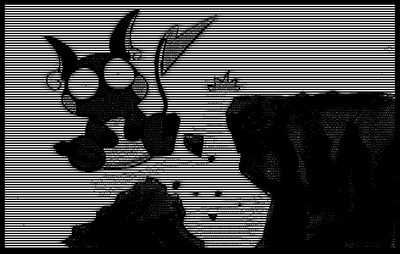AndrettiGTO wrote on 2024-02-20, 01:57:
Jo22 wrote on 2024-01-02, 10:57:
PS: I've taken some more pictures, for you and Grzyb. It's about Blockout on CGA.
Depending on the CRT monitor, the dithering really works. 😄
Excellent example of a game designed to maximize the hardware it’s running on.
CGA had many unsupported display modes that several publishers of the time took advantage of.
Thanks, I admit I have a bit of a love/hate-relationship with CGA.
One one hand, I love to tinker with it, while simultaneously wished there was "more".
There were missed opportunities so to say.
Like a 4 colour mode for 640x200 resolution or a 640x400 mono mode.
Both would have helped at increasing the level of detail in games back in the day.
Ok, strictly speaking, such CGA modes do exist!
..just not for official IBM CGA. 🙁
640x200 4c is being part of Plantronics and Tandy/PCJr, which are "Super CGAs" of some sort.
Plantronics has full 32KB of RAM, for example.
The full RAM expansion that IBM CGA should have had from very start.
I'm saying this because IBM CGA uses 16KB of RAM, but has an 32KB wide framebuffer slot.
Ie, it uses 16KB for graphics data, but it's being doubled (the cause was incomplete address decoding, I assume. A hardware bug).
Some games/applications may even depend on that mirror copy, not sure.
When that's not the case with some applications, though, CGA can have 200 more lines! 😃
That's exactly what the Olivetti M24/AT&T6300 graphics hardware does.
In high-res mode, it adds more lines to the image, using the memory location where the duplication of CGA image data would be.
(So it wouldn't exceed the official CGA framebuffer area, even!)
But the drawing is done not by adding more lines below the existing one, but in-between.
I don't know how to put this into words properly.
Let's just think of it as an image with stripes.
In normal CGA high-res mode on the M24 monitor, there would be 200 black lines (stripes) visible between the actual CGA picture
(in reality, the M24 hides this for better readability. It duplicates each line in normal CGA modes; like VGA does).
With the 400 lines Olivetti/AT&T mode, these black lines (stripes) wouldn't be black (empty) but would contain lines with actual graphic data.
Thus, the image would be twice as detailed.
But now the really interesting part.
If such a 400 line image would be cross-loaded on a plain CGA card, the image might still being visible.
The extra Iines that sit "in-between" would be merely missing. The picture would be more grainy looking.
Edit: As a visual aid, please have a look about how interlacing of graphics files works.
Like interlaced GIF, for example.
I've recorded a quick video about that a few years ago. 😅
Again, depending on the hardware/application.
It might be possible that under some circumstances, the missing "copy" of the second,
identical 16KB CGA image block (the alias) would cause weird effects, not sure.
Anyway, speaking under correction. I just found this to be interesting.
Because, in practice many CGA cards weren't just plain CGA cards.
In same way like almost all "VGA cards" were Super VGA cards, really.
Same goes for many EGA clones. They had extra modes we may not know of.
Let's just think about it. How many CGA cards or Hercules cards do secretly feature enhanced functionality? 😃
Many CGA cards supported Plantronics or the AT&T mode, especially if being part of a system
with built-in monitor (which can do more than 200 lines thanks to custom timings).
PC emulator cards for Atari ST and Amiga did support Tandy and AT&T/Olivetti or Toshiba modes, too.
They also did Hercules, in clever way.
Some ran the monitor with special timings, used interlacing or used a scrolling feature.
Personally, that's what I find so fascinating about old hardware and software!
There's still something new to learn and to discover each time! 😃
Edit: Edited. I've taken some screenshots for the M24/Olivetti thing.
I hope the OP doesn't mind. Art found online, if someone knows the artists, please tell so I can provide credits. 😀
"Time, it seems, doesn't flow. For some it's fast, for some it's slow.
In what to one race is no time at all, another race can rise and fall..." - The Minstrel
//My video channel//



